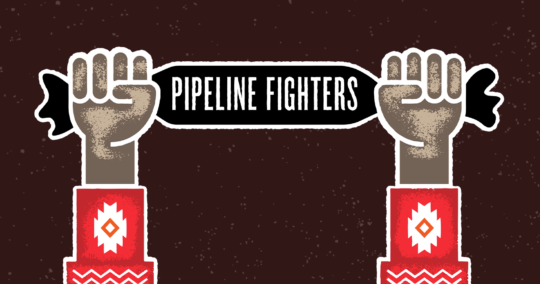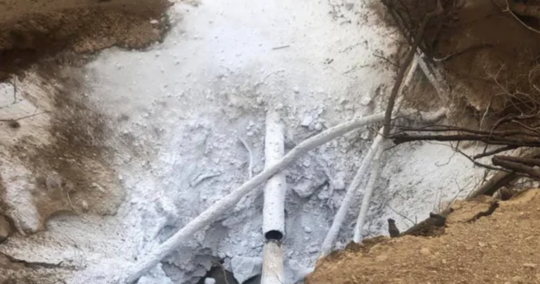

That afternoon in November 2013, Sandhill cranes squawked and danced in the distance. Faith Spotted Eagle an elder of the Ihanktonwan Band of the Dakota/Nakota/Lakota Nation of South Dakota, pulled her shawl tighter against the wind and cold, then began to sing. She was gathered with other members of the Cowboy and Indian Alliance in the 160-acre cornfield of Art and Helen Tanderup near Neligh, Nebraska, to bless the land. Afterward, everyone stooped into a tipi, purchased by Bold Nebraska and constructed in Oregon by Nomadic Tipi Makers. The previous day Faith’s grandson Kevin, a shy, young twenty-something, had led a small group of landowners affected by the proposed route of the Keystone XL pipeline in raising the tipi. Inside now, the group huddled around a small fire. They burned sage and prayed to Mother Earth. Then each member shared stories about why they had chosen to fight the pipeline, what it meant to them as individuals and to their families.
Mekasi Horinek—a member of the Ponca Tribe of Oklahoma and son of Casey Camp-Horinek, a long-time Native rights activist and environmentalist—admits that when his mother first told him about the Cowboy and Indian Alliance he was skeptical about working with non-natives. “I’ve always been a little bit bitter toward white society,” he said. “I’ve experienced a lot of racism—growing up on the res, living on the res. When I went to town I was always treated differently than others.” But his mother reasoned that the people who live on Ponca ancestral land, like the Tanderups, have developed their own connection to the land. “Their mothers, their fathers, their grandmas and grandpas are buried in the soil the same way that ours are,” explained Horinek. “They have that love and respect for the land the same that we do.”
Convinced by his mother’s words, Horinek and his two youngest sons drove from Ponca City, Oklahoma, to Neligh. Now sitting in a tipi listening to Art explain how his land was crossed by the historic Ponca Trail of Tears on one side and the proposed route of the Keystone XL pipeline on the other, Horinek, whose great grandfather was among those who were forcibly removed to Oklahoma, was deeply moved and began thinking about how best to help the Tanderups protect their land from the pipeline. Planting sacred Ponka red corn came immediately to mind.
* * *
In May 1877, the U.S. Army forcibly removed the Ponca from their land between Ponca Creek and the Niobrara River (approximately between present day Butte and Lynch, Nebraska) to Indian Territory in Oklahoma. The strenuous journey, plagued by extreme weather, claimed the lives of nine Ponca, including Chief Standing Bear’s daughter, Prairie Flower, who was buried in Milford, Nebraska, and White Buffalo Girl, the Daughter of Black Elk and Moon Hawk, who was buried by the people of Neligh, Nebraska. Today, a marble monument marks her grave in Laurel Hill Cemetery in Neligh.
Because they were removed in May, the Ponca had already planted their corn crop and were forced to leave with few corn seeds. When they arrived in Oklahoma at the end of the summer it was too late to plant and the community faced starvation. As a result of these conditions, Chief Standing Bear’s eldest son Bear Shield died in Oklahoma. To fulfill a promise that he made to Bear Shield to bury him in his homeland of Nebraska, Standing Bear traveled north with his son’s body and a group of 65 followers. They were detained in Omaha.
Standing Bear sued the U. S. Army for forcibly removing the Ponca from their homeland—and won. In 1879, he was granted a writ of habeas corpus. The judge ruled that “an Indian is a person” and that the Federal Government had failed to show basis under the law for the arrest and captivity of the Ponca. Standing Bear and many of his followers returned to their home on the Niobrara River and became known as the Ponca Tribe of Nebraska. Those who remained in Oklahoma were registered as the Ponca Tribe of Indians of Oklahoma under the Dawes Allotment Act of 1892.


After Horinek returned home from the spiritual camp in Neligh, he immediately contacted his relative, Amos Hinton, the Agricultural Director of the Ponca Tribe of Oklahoma, who has been working to find and restore the tribe’s five varietals of heirloom corn and establish a seed bank to preserve the seeds for future generations. In 2012, he worked with Nebraska corn geneticist, Tom Hoegemeyer, the Nebraska Department of Agriculture, the Nebraska Commission on Indian Affairs, and the Intertribal Agricultural Council to plant Ponka grey corn seeds near Kearney with the assistance of the Pawnee Tribe. (The nineteenth-century spelling of the tribe is still used in the official names of the Ponca corn varietals.) The successful planting yielded hundreds of pounds of heirloom seeds. Hinton’s hope is that the Tanderup farm will be maintained as another growing site for the historic corn varietals. “In our creation story the Creator gave us three original gifts: red corn, a dog, and a bow,” explained Hinton. “I am honored to be able to provide my tribe with this historic sacred red corn, which we had not seen since my people were forced to leave Nebraska.”
“I’ve been involved in agriculture my whole life,” said Hinton. He takes great pride in the horses that he owns, in growing his own food, and in subsistence hunting. But he did not make a living in agriculture; for 25 years he worked as a Union pipe fitter and welder in the refineries and chemical plants around Ponca City. He often worked side by side with his younger brother, Harvey. “He was my shadow; we were always together.” In 2011, when Harvey was diagnosed with terminal pancreatic cancer, Hinton rented out his house and moved in with his brother so that he could help take care of him. As he watched Harvey dwindle from 265 pounds to 110 pounds, Hinton struggled with the question, “Why him and not me?” At Harvey’s funeral, he remembers Mekasi Horinek telling him, “I know you feel alone, but you’re not. From here on, I’m your brother.” The two have been close ever since.
Awakened by the reality of his brother’s death, Hinton became alarmed by the rates of cancer and diabetes in his Tribe. He wanted to encourage a return to simple, traditional foods and began working with tribal members to grow their own crops. Hinton soon began a quest to find the lost Ponca corn seeds. Through his initial work with the Pawnee Tribe, he first recovered Ponka blue corn seeds. But it was the sacred red corn that was most important to Hinton. He eventually found a Lakota family in Craig, Nebraska, whose ancestors had harvested the Ponka red corn from the banks of the Niobrara River in the fall of 1877, and had continued to plant and harvest the corn to the present.


Organized by Horinek and Hinton, members of the Cowboy and Indian Alliance came together on the Tanderup farm on Saturday, May 31, to hand plant sacred Ponka red corn seeds. “Our family is honored to have sacred Ponca corn seed planted here on our farm,” explained Tanderup. “The people of Neligh, in 1877, assisted the Ponca by burying White Buffalo Girl. Over one hundred years later, that spirit of humanity continues as we join with our friends and neighbors in replenishing their sacred corn and fighting against Keystone XL.” About thirty members of the Cowboy and Alliance gathered together on a quarter section of the farm as Mekasi Horinek and Amos Hinton led the group in a planting ceremony.
Under the threat of storm clouds, on recently tilled sandy soil, Horinek and Hinton laid out a blue blanket on which they placed a basket of Ponka red corn seeds, a jar with water from the Ogallala Aquifer, a sacred pipe, a sage bundle, and sweetgrass braid. Hinton dug a small hole next to the blanket to burn the sage and sweetgrass. As the group formed a circle around the blanket, Horinek began the ceremony with a prayer to the four directions and later he loaded the sacred pipe with a mixture of tobacco and red willow bark. He then explained to the group the importance of protecting the land and restoring the corn, “Together our families will plant sacred red corn seed in our ancestral soil. As the corn grows it will stand strong for us, to help us protect and keep Mother Earth safe for our children, as we fight this battle against the Keystone XL pipeline.” He then passed around the jar of water from the Ogallala Aquifer and asked each member to drink from it. He also revealed a greater purpose for planting the corn. When Horinek had first conceived of the idea, his hope was that by planting sacred Ponka red corn, the land would become sacred too, and that the Tanderup’s could ask for protection from the pipeline under the Freedom of Religion Act.
After the ceremony, Tanderup climbed aboard his old John Deere tractor to set the 30-inch spacing between the rows. The group of planters lined out behind him and began planting down the rows—some using just their hands while others protecting their backs, used a stick to make the hole for each seed, and then drop, cover and repeat. Even through claps of thunder and occasional hard rain, everyone enthusiastically focused on the planting. After two days, more than sixty volunteers had successfully hand planted 3.5 acres of heirloom corn. Together with the sacred red corn, the Alliance also planted Hopi sweet corn (white), and Ponka grey corn (blue) to symbolize the group’s independence and freedom. They also planted painted-desert corn seeds to symbolize unity.
Despite a devastating hailstorm in early June, the Ponka red corn and the other varietals planted by the Cowboy and Indian Alliance are emerging. Art Tanderup reports, “I can still see the many footprints, handprints, and even some kneeprints from the more than sixty volunteers who took such care in gently placing every kernel at the proper depth and spacing.” Weeding begins in July and harvest is expected in October.














